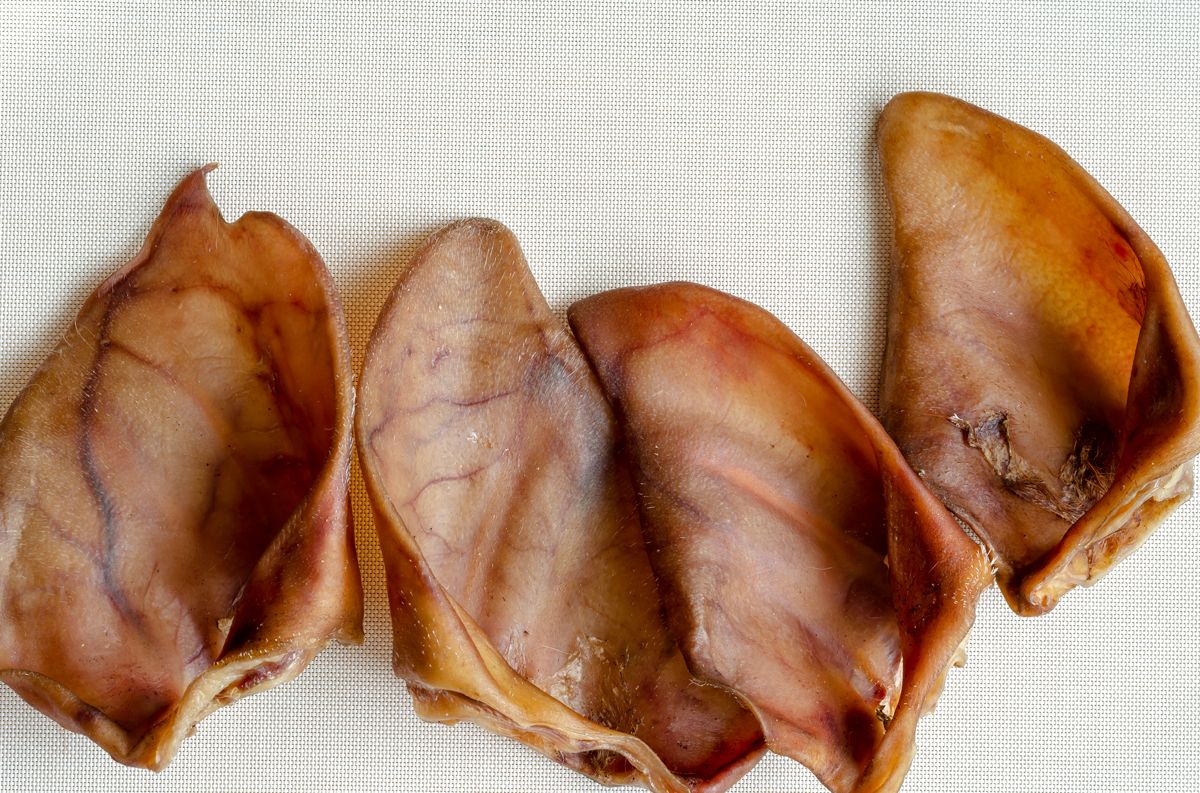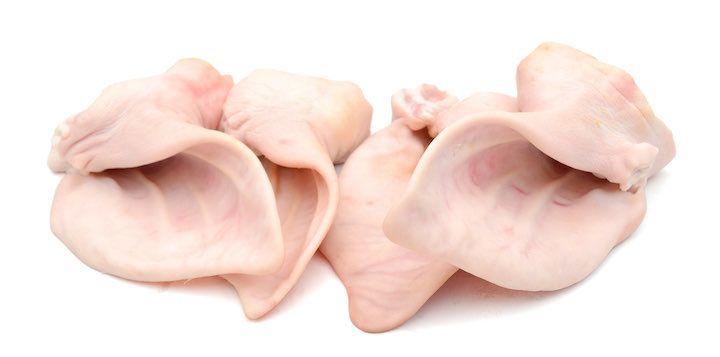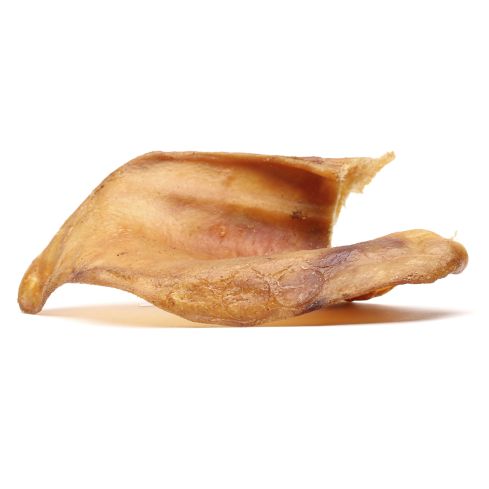Product added to cart
- Home
- The Chew: Bully Stick Blog
- Are pig ears good for dogs?

Are you wondering if that pig ear you are feeding your dog is good for them?
As more pet owners become concerned with what they’re feeding their beloved pets, many popular chews have come under intense scrutiny.
As a result, many owners are foregoing rawhide in favor of more natural options.
Yes, Pig ears are good for dogs. They can help remove plaque & tartar, provide mental stimulation and are a great source of protein.
However, pig ears aren’t right for every dog, so it’s important to consider all factors before giving your dog a pig ear to chew on.
Read on or feel free to skip ahead
Pros of Feeding Pig Ears
Pig ears are a single ingredient treat, which means they’re ideal for dogs with dietary restrictions or food sensitivities.
It’s easy to know exactly what you’re feeding your beloved companion when there’s only one ingredient to worry about.
As long as you’re buying high-quality pig ears from a reputable source, you can be sure that they are free from chemicals and additives that may cause digestive upset.
Nutritional Benefits
Pig ears are made of cartilage, which means they are a softer chew that’s ideal for most dogs. Whether you have a puppy, a senior, or a dog with dental problems, pig ears are long lasting, but easy to chew.
Pig ears are also an excellent source of glucosamine and chondroitin, which can help relieve painful joint conditions such as osteoarthritis. These ingredients also contribute to healthy teeth, gums, and skin.
The high protein content of pig ears, around 69%, will help keep your dog develop strong muscles and a healthy coat and skin. They’re also a great source of essential amino acids.

Behavioral Benefits
Chewing on a product such as pig ears provides your dog with many benefits. Depending on your dog’s size and chewing capabilities, a pig ear can last anywhere from just a few minutes to several hours.
Some companies also sell pig ears that have been trimmed into smaller pieces or slices to accommodate particularly small dogs, seniors, puppies, or any dog with limited chewing capabilities.
Not only is chewing is a great way to keep your dog out of trouble, but it is mentally stimulating as well. Mental stimulation is key in preventing the development of bad habits created out of boredom, especially when combined with appropriate physical exercise.
Mental stimulation is especially important for dogs with limited mobility, such as young puppies, elderly dogs, and those with physical limitations. Their bodies may not be able to handle strenuous physical activities, but chewing will help keep their mind and body busy without discomfort.
Health Benefits
In addition to the satisfaction of chewing, pig ears can help scrape away plaque and tartar. Along with regular veterinary dental care, pig ears can help keep your dog’s teeth clean and prevent dental disease.
Finally, pig ears are also relatively inexpensive when compared to other high quality chews, such as bully sticks or cow ears, especially if you’re able to buy them in bulk.
Cons of Feeding Pig Ears
High Fat Content
One of the biggest cons of feeding pig ears to your dog is the calorie content. Pig ears are rather large treats with a fairly high fat content. Moderation is key when it comes to this type of treat.
The average pig ear contains around 100 calories but may vary greatly due to the size of each ear. Though that may not seem like much, it can be a large portion of a small dog’s daily calorie allotment. To prevent weight gain, it’s recommended to feed pig ears just once or twice per week, depending on the size of your dog.
The higher fat content may also be a problem for dogs requiring low fat diets. Pork is generally not considered a low fat food, so if your dog requires minimal fat in his diet for any reason, it may be best to choose a chew made from another type of protein.
Not Right For Every Dog
Pig ears generally last quite a while, but for more tenacious chewers, this may not be the right treat to keep your dog busy for more than a few minutes. For these types of dogs, tougher chews such as bully sticks are recommended.
Some dogs may also be prone to swallowing their treats whole. Whole pig ears are large enough to cause an intestinal blockage, or even choking, if they are swallowed whole.
For smaller dogs, even a large chunk of a pig ear can be large enough to cause problems.
Safely Feeding Your Dog Pig Ears
As with any treat, safety should always be your top priority when feeding your dog pig ears. By following a few basic guidelines, you can help keep your dog safe while allowing him to enjoy his favorite treat.
Choose High Quality Products
When shopping for pig ears, make sure your dog gets only the highest quality pig ears that are free from chemicals, additives, and preservatives.
Remember, pig ears are a single ingredient treat and they do not need added chemicals or flavors. Be sure to purchase your dog’s treats from a reputable vendor to ensure that they’re made from quality ingredients.
Supervision is Necessary
To ensure a safe chewing experience for your dog, be sure to supervise your dog while he’s chewing on his pig ear. Some dogs may chew responsibly, while others may try to swallow the whole ear or tear off large chunks to swallow.
As previously mentioned, if your dog manages to swallow the entire ear, or a large chunk, he could be at risk of an intestinal blockage. To prevent this, consider holding on to the ear while your dog chews until he understands that he isn’t supposed to swallow it in one piece.
Hygienic Handling
After handling any pig ear, be sure to wash your hands with soap and water. In 2019, the FDA investigated pig ears that had been contaminated with salmonella. It’s worth noting that most of the pig ears involved in the investigation were produced overseas.
Though no dogs ever became ill, 154 people did. In general, a healthy dog’s digestive system is equipped to handle bacteria such as salmonella without causing illness. However, a human’s digestive system is much more sensitive and can be affected far more easily.
You can minimize this risk by washing your hands after handling pig ears and wiping any surfaces the ears come into contact with. This is especially important if you have people in your home with compromised immune systems.
Can Puppies Have Pig Ears?
Pig ears are a popular treat for puppies.
They are a natural and flavorful snack that can keep your puppy entertained for a while, satisfying their need to chew.
However, it's important to keep in mind that pig ears can be high in fat and calories, so it's important to feed them in moderation and factor them into your puppy's overall diet.
Additionally, some dogs may have allergies to pork or be sensitive to high-fat foods, so it's always a good idea to monitor your puppy's reaction to pig ears and consult with your veterinarian if you have any concerns.
Finally, it's important to supervise your puppy when giving them a pig ear to avoid choking or swallowing large chunks.
Tips on feeding pig ears to puppies
- Wait until about 6 months of age before feeding
- Feed in moderation
- Look for digestive reaction for allergies or digestive issues
- Monitor chewing to prevent choking or swallowing large pieces
How to Choose the Best Pig Ears for Your Dog
To ensure your dog’s health and safety, it’s essential to buy only the best treats for your dog. To choose the best pig ears, it’s important to buy them only from reputable vendors who use high quality ingredients.
Country of Origin
Not all pig ears produced overseas will contain harmful ingredients such as bacteria or preservatives, but many experts recommend choosing pig ears produced within your home country.
If you’re buying individual ears from a local retailer, rather than a package, you might consider asking the retailer where the ears come from and how they can be sure that the ears are not contaminated in any way.
If possible, you should also look for pig ears from pasture raised pork. In general, pasture raised pork is healthier than factory farmed pigs.
Pasture raised pigs also have a better Omega-6 to Omega-3 ratio. Omega-3 and Omega-6 are essential to good cardiac health and a shiny coat.
We only source the highest quality farm-raised pig ears from Central & South America.
Cooking Method
It’s best to avoid pig ears that have been smoked or those that contain added flavors.
These products typically contain chemicals or ingredients that may be harmful or put your dog at risk of digestive upset.
Some retailers may also sell raw pig ears.
For dogs that eat a raw diet, raw pig ears can be a great way to give your dog the enjoyment of chewing a pig ear without straying from his normal diet.
However, raw pig ears can be difficult to find, so you may need to search for ears that have been cooked.

When shopping for chews, it’s recommended to look for pig ears that have been baked or slow roasted.
These ears are typically of the highest quality and do not contain any harmful added ingredients.
Baking and roasting also helps preserve as much nutrition as possible throughout the cooking process.
The Best Pig Ears
At BullyStick.com we only sell the highest quality pig ears. Slow baked in industrial ovens to ensure your dog has the safest chew possible.
- Pig Ears - WholeAs low as $12.00
Recent Posts

